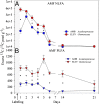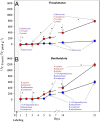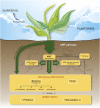Shifting carbon flow from roots into associated microbial communities in response to elevated atmospheric CO2
- PMID: 20534474
- PMCID: PMC2890735
- DOI: 10.1073/pnas.0912421107
Shifting carbon flow from roots into associated microbial communities in response to elevated atmospheric CO2
Abstract
Rising atmospheric CO(2) levels are predicted to have major consequences on carbon cycling and the functioning of terrestrial ecosystems. Increased photosynthetic activity is expected, especially for C-3 plants, thereby influencing vegetation dynamics; however, little is known about the path of fixed carbon into soil-borne communities and resulting feedbacks on ecosystem function. Here, we examine how arbuscular mycorrhizal fungi (AMF) act as a major conduit in the transfer of carbon between plants and soil and how elevated atmospheric CO(2) modulates the belowground translocation pathway of plant-fixed carbon. Shifts in active AMF species under elevated atmospheric CO(2) conditions are coupled to changes within active rhizosphere bacterial and fungal communities. Thus, as opposed to simply increasing the activity of soil-borne microbes through enhanced rhizodeposition, elevated atmospheric CO(2) clearly evokes the emergence of distinct opportunistic plant-associated microbial communities. Analyses involving RNA-based stable isotope probing, neutral/phosphate lipid fatty acids stable isotope probing, community fingerprinting, and real-time PCR allowed us to trace plant-fixed carbon to the affected soil-borne microorganisms. Based on our data, we present a conceptual model in which plant-assimilated carbon is rapidly transferred to AMF, followed by a slower release from AMF to the bacterial and fungal populations well-adapted to the prevailing (myco-)rhizosphere conditions. This model provides a general framework for reappraising carbon-flow paths in soils, facilitating predictions of future interactions between rising atmospheric CO(2) concentrations and terrestrial ecosystems.
Conflict of interest statement
The authors declare no conflict of interest.
Figures




References
-
- Intergovernmental Panel on Climate Change Climate Change 2007 Synthesis Report. Summary for Policymakers. 2007. [Accessed November 1, 2007]. Available at www.ipcc.ch.
-
- Ainsworth EA, Long SP. What have we learned from 15 years of free-air CO2 enrichment (FACE)? A meta-analytic review of the responses of photosynthesis, canopy properties and plant production to rising CO2. New Phytol. 2005;165:351–371. - PubMed
-
- Strand AE, Pritchard SG, McCormack ML, Davis MA, Oren R. Irreconcilable differences: Fine-root life spans and soil carbon persistence. Science. 2008;319:456–458. - PubMed
-
- Körner C, Arnone JA., 3rd Responses to elevated carbon dioxide in artificial tropical ecosystems. Science. 1992;257:1672–1675. - PubMed
-
- Zhou GY, et al. Old-growth forests can accumulate carbon in soils. Science. 2006;314:1417. - PubMed
Publication types
MeSH terms
Substances
Associated data
- Actions
- Actions
- Actions
- Actions
- Actions
- Actions
- Actions
- Actions
- Actions
- Actions
- Actions
- Actions
- Actions
- Actions
- Actions
- Actions
- Actions
- Actions
- Actions
- Actions
- Actions
- Actions
- Actions
- Actions
- Actions
- Actions
LinkOut - more resources
Full Text Sources
Molecular Biology Databases
Miscellaneous

